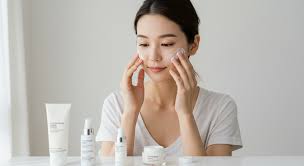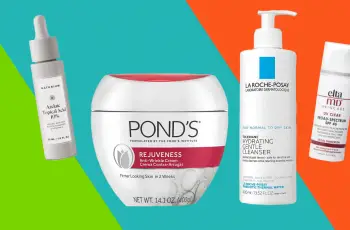
Layering skin care ingredients properly can be the key to transforming your routine into a powerful regimen that targets your skin’s specific needs with maximum results and minimal irritation.
The order in which you apply products affects how well each ingredient penetrates, how it interacts with others, and how effectively it performs on your skin day after day.
Layering isn’t just about texture—it’s also about chemistry, ingredient compatibility, and the timing of your application throughout the day or night.
Before you start layering, it’s crucial to know your Baumann Skin Type, which determines what ingredients are best for your skin and how to layer them safely and effectively.
Our quiz helps determine your Baumann Skin Type so we can build a personalized skin care routine with product recommendations that are ideal for your skin and ordered in the most effective layering sequence.
Many ingredients chemically interact when combined, and these interactions can either boost or diminish product performance depending on when and how you apply them.
There are four ways ingredients can interact: when formulated together, when mixed by hand before application, when layered on the skin, and when applied at different times of day.
Layering matters—some product combinations enhance benefits, while others lead to reduced efficacy or even cause sensitivity, clogged pores, or skin barrier damage.
A perfect example is layering retinoids with moisturizers, which changes the strength and absorption of the retinoid depending on what comes first.
Some guides suggest waiting 3–10 minutes between layers, but if your routine is well-designed, waiting may not be necessary since each layer supports the next.
That’s why a professionally curated routine that considers both ingredient compatibility and skin type is far more effective than trial and error.
Our quiz ensures your personalized routine has the correct order so ingredients interact properly and your skin absorbs everything it needs without irritation.
Let’s talk about serums and acids—a tricky but important part of layering, especially since acids alter skin pH and impact how serums work.
The best method to layer a serum and an acid is to use a low-pH acid cleanser, like one with hydroxy acids, then rinse thoroughly before applying your serum.
This temporarily lowers your skin’s pH, making it more permeable so that vitamin C, peptides, and other active serums can sink deeper into your skin layers.
Using acid cleansers before vitamin C serums enhances the absorption of ascorbic acid and increases exfoliation, promoting more radiant and youthful skin.
These cleansers also help loosen dead skin cells so your serums can reach fresher skin, making them more potent and effective in your overall regimen.
However, you should avoid layering acidic moisturizers directly with certain serums because they can deactivate or destabilize sensitive ingredients.
For example, peptides and growth factors are prone to breakdown in acidic environments, so avoid combining these with glycolic or lactic acid creams.
Applying exosome serums after acidic moisturizers may destroy their structure before they reach deeper skin levels, greatly reducing their benefits.
Because there are 16 different Baumann Skin Types, it’s important to know yours before mixing acids, serums, peptides, or growth factors in your routine.
One of the most complex ingredients to layer correctly is retinol, and it deserves its own detailed breakdown to prevent irritation and maximize results.
Whether you use over-the-counter retinol or prescription-strength Retin-A, the order and combination of ingredients you use with it can make or break your routine.
Let’s begin with retinol and serums—should retinol go before or after a serum? It depends on what’s in your serum and your personal skin sensitivity level.
If your serum is hydrating and soothing, like one with hyaluronic acid or niacinamide, it may be beneficial to apply it before or after retinol to buffer irritation.
Peptides and retinol together can be problematic, as peptides often clump or inactivate other actives, so avoid layering them unless guided by a dermatologist.
If your peptide serum lists peptides low on the ingredient list and is in a separate product from retinol, it might be okay, but caution is still advised.
Retinol and vitamin C are powerful together but should not be used in the same product—vitamin C in the morning and retinol at night is the ideal combination.
This separation prevents ingredient instability while still giving you antioxidant protection in the day and cell turnover benefits at night.
Combining retinol and glycolic acid in the same product can cause excessive irritation, so most dermatologists recommend using them at different times or alternating days.
If you like AHAs, use an AHA cleanser in the morning and a separate retinoid product at night to avoid irritation and give your skin flexibility.
This method also allows you to pause one or the other if irritation occurs without disrupting your entire skin care regimen.
Now let’s talk about layering serums and moisturizers—usually, serums come first because they’re water-based and meant to penetrate, while moisturizers seal them in.
However, if your serum is actually a face oil, the order changes since oils act as occlusives and should be applied after your cream to lock moisture in.
There are many types of oils—some are essential oils and not true moisturizers, and others vary in absorption, weight, and function, so placement matters.
In most cases, face creams go first, then face oils on top to create an occlusive barrier that traps hydration and enhances product absorption.
Let’s dive into specific brand routines, starting with SkinMedica, which has a well-known line of high-performance medical-grade products.
Always start with TNS Recovery Complex or any growth factor serum—these delicate ingredients must absorb first without competition from thicker products.
Next, apply SkinMedica Lytera, which targets pigmentation, either second or third depending on your skin type’s needs and tolerance.
Follow with the HA5 hyaluronic acid serum to improve hydration and absorption—be careful as it can enhance retinol’s potency and irritation.
Apply SkinMedica Dermal Repair Cream or moisturizer after your serum to seal in hydration and support skin barrier repair.
Retinol should always be applied at night and placed after TNS Essential Serum, but only if your skin type can tolerate it in combination.
Now let’s discuss layering SkinCeuticals products, a favorite brand among dermatologists for its antioxidant-rich serums and retinoids.
Start with a gentle cleanser, followed by a vitamin C serum such as C E Ferulic, Phloretin CF, or AOX10 depending on your needs.
Then apply a hyaluronic acid serum to draw in moisture, followed by the Triple Lipid Repair moisturizer to strengthen your barrier and reduce sensitivity.
Finish your night routine with retinol—SkinCeuticals’ version is potent, so consult a dermatologist to ensure your skin can handle it properly.
Even with a great brand like SkinCeuticals, this step order may not suit all 16 Baumann Skin Types, so take the quiz before investing in products.
Next up is La Roche-Posay, known for its soothing formulas and dermatologist-tested ingredients suited for sensitive skin.
In the morning, use their 10% Pure Vitamin C Serum after cleansing to brighten and protect against environmental damage.
If you’re starting retinoids, use Effaclar Adapalene 0.1% gel at night and layer it after your moisturizer to buffer irritation.
Hydraphase HA Moisturizer or face cream should be used according to your skin type to avoid over-hydration or increased sensitivity.
Always apply sunscreen last in the morning and stick to retinol products at night for the best results with minimal irritation.
Drunk Elephant is another popular brand people ask about, although it’s not medical-grade, it can still work well with proper layering.
Here’s a typical morning routine with Drunk Elephant: ERase Milki Micellar Water, Shaba Eye Serum, C-Firma Fresh Day Serum, Protini Cream, then SPF.
For nighttime: Beste No. 9 Jelly Cleanser, CeraMighty Eye Balm, Glycolic or Vitamin C Serum, Lala Retro Cream, Retinol Cream, then Marula Oil.
No matter which brand you use, remember that layering in the right order is critical—your results depend on both the product and the timing.
I prefer blending top products from multiple brands based on the patient’s skin type, needs, and tolerance rather than sticking to one brand exclusively.
To get the same recommendations I give my patients, take the quiz and receive a fully personalized routine backed by dermatology science and expertise.
You’ll know exactly which ingredients to use, in what order, and how to combine them for powerful results tailored to your skin’s unique biology.


